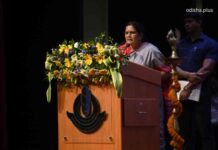Bhubaneswar, a city that blends spirituality, modernity, and contradiction. From ancient temples to bustling malls, from cultural festivities to quiet skepticism, the city reveals itself as a place of many moods and endless fascination.
Snehaprava Das

My impression of Bhubaneswar is limited to my brief acquaintance with the city. I shifted to Bhubaneswar less than a decade ago. I taught in the Department of English at Utkal University for a few years as a guest professor till the outbreak of the pandemic. For me, there is no specific area of experience to draw upon for offering a personal view of the city. But I have observed the happenings, visited significant places, and experienced the changing moods of the city. My impression of Bhubaneswar, therefore, is not exclusive or selective. It is rather a broad overview of the city as a whole.
Cities, I believe, are like the personae in a never-ending play, revealing amazing contours of their character, unfolding a mélange of moods. A city is a strange amalgamation of many contradictions, of heterogeneous elements, and interesting diversities. In the words of Roman Payne, ‘Cities were always like people, showing their varying personalities to the traveler.’ And for Italo Calvino, ‘Cities like dreams are made of desires and fears.’
Bhubaneswar, the capital city of Odisha, is a fast-evolving, fast-expanding cosmopolitan city that gathers in its fold people hailing from different social, cultural, and economic backgrounds. Besides being the center stage of action of the state politics, it is a city that encompasses diverse ideologies and customs, nonhomogeneous cultures, and non-uniform social dynamics.
The city has an ambiance that is a blend of serenity and glamour. While the holy lake of Bindu Sagar and the temples of Lord Lingaraj, the RajaRani temple, the Mukteswar temple, and other such sacred structures and the elegant churches and mosques define a spiritual scenario collecting a heterogeneous humanity in the bond of faith, the swanky malls, shopping complexes, high rise buildings, the multiplexes build up an urbane scenario of a rapidly growing Bhubaneswar. It is a city of multistoried apartments and dingy slums, a cluster of smart and sophisticated academic institutions, and a handful of low-budget schools and colleges.
Bhubaneswar is a happening city that never sits idle but bustles with activities. Here we witness people celebrating festivals of all religions with equal fervor and involvement. There will be an endless series of fairs and exhibitions, each of them a cornucopia of exotic items to attract connoisseurs and shopping enthusiasts.
At the same time, the objective is to promote the sale of regional and local handicrafts and artifacts designed in various parts of the state as well as the country itself. Enactment of plays and performance of cultural programs are a routine evening occurrence here. Bhubaneswar, viewed from this angle, appears to be an elegant city of fairs and festivities and of glamour that lives through the days of joie de vivre and nights of revelries and resplendence. The city celebrates national events with great interest and enthusiasm, steeped in the spirit of universal brotherhood.
Bhubaneswar seems to exercise a mysterious, magical pull over people, inveigling them from all places to it, inspiring them to try their luck here. It is an interesting city, a city for the achievers and the strugglers, for the fortune seekers and the dream chasers, for the gold diggers, the bootleggers, and the carpetbaggers. It is a city of promises and possibilities where anonymity can gain an identity. One may even agree with Jane Jacobs that … ‘Cities have the capability of providing something for everybody…’
I observe that as an important tourist destination, Bhubaneswar has many unique features to attract people from all over the world. Besides the impressive temples exemplifying sculptural miracles, the city also flaunts the peace-memorial (Santi -Stupa) at the historical Dhaulgiri hill and the rock-cut caves of Khandagiri and Udayagiri. Amongst the other significant tourist spots are the Nandankanan Zoological Park, a zoo and a botanical garden that includes a lion safari, the Odisha State Museum, which showcases a wide collection of historical exhibits, and the State Tribal Museum displaying tribal craft.
Bhubaneswar has several opportunities to offer to aspiring youth, students, the job seekers. There are several universities and academic institutes of wide acclaim here that not only impart good education but also offer a promise of sustainability, and students vie with one another to get selected for those. The place is also a fast-developing IT hub that offers lucrative job opportunities to the eligible youth mass. Maybe what Simon Van Booy says, ‘For those who are lost, there will always be cities that feel like home’ applies quite appropriately to Bhubaneswar.
Bhubaneswar is a city of many moods. Like all other cities with a glamorous and captivating façade, it too has its intense moments of doubt and despair. Bhubaneswar gifts the dwellers here a great living experience, but underneath, there remains hidden a sense of insecurity, a mood of skepticism.
Bhubaneswar is a city of paradoxes.
It spells a simultaneity of connection and apathy, of togetherness and estrangement, of flourishing and frustration. People live together under one roof in one apartment building, the doors of their units facing one another but remain strangers. It has its mood of merrymaking but also one of grim consternation as it watches the angry protests at city squares, the loud political rallies, the high-voltage mob violence, the exasperating traffic jams, and other such unpleasant incidents. Like most Indian cities, it also exposes many faces of hunger, fear, crime, and mishaps. The picture of the downtrodden, derelict scatters of humanity at the traffic signals, on the sidewalks, on the foyers, and the steps of the temples… unveils a gloomy contour of this city of glamour.
To sum up, Bhubaneswar, like other big cities, is a resilient one that survives not only the lashes of changing seasons but those of changing political and social climates. It lives through contradictions and controversies and still maintains its glory. It is one of the most ideal cities I have ever known, and an amazing place to live in and explore life.
(Snehaprava Das is an Associate Professor of English, author, poet, and translator)

























